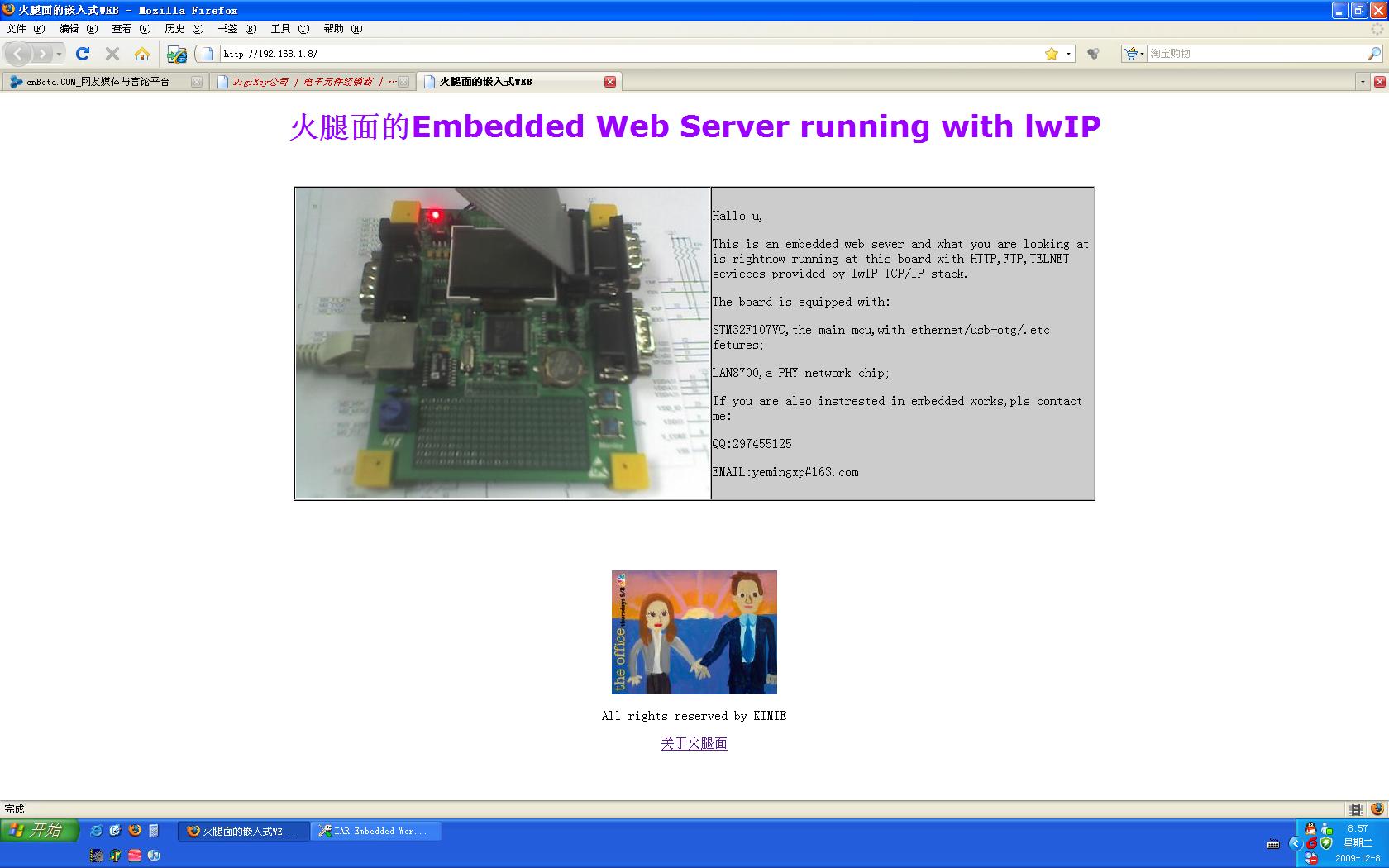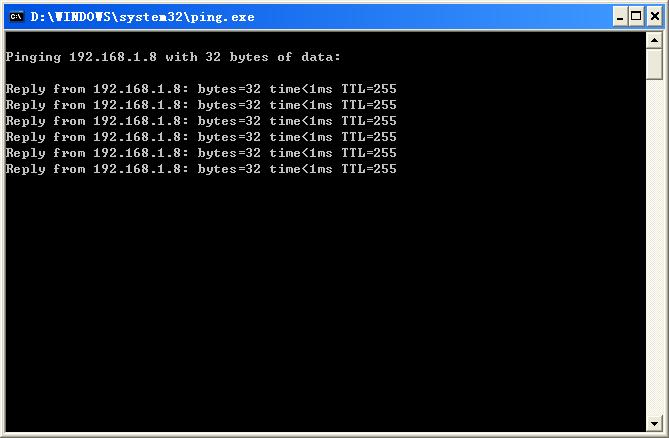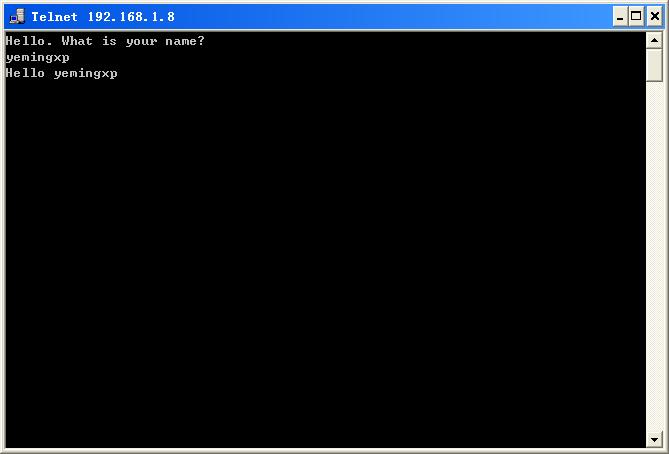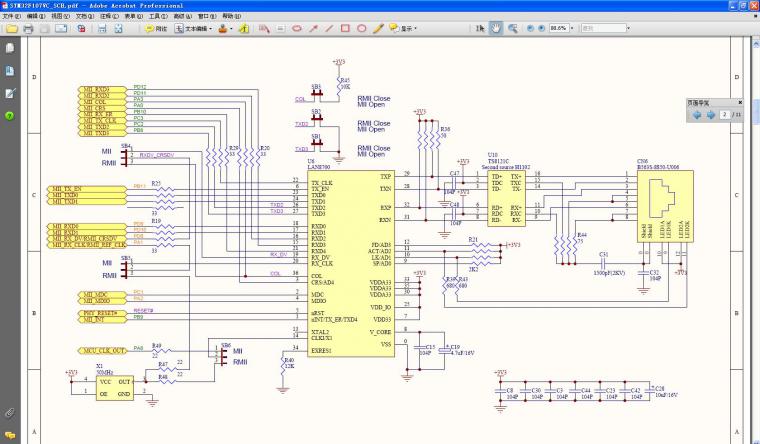F107的板子上周拿到手了,没时间折腾,不知道相比之前官方推出的NicheLite协议栈有多大优势或者缺点,要学习,要学习的实在太多了,先把资料放上来,此应用实现了以下功能,硬是安逸..
The objective of this application note is to present a demonstration package built on top of a
free TCP/IP stack: the lwIP (lightweight IP). This package contains:
● A DHCP client, for IP address setting
● A Hello example based on the Telnet protocol
● A TFTP server, which transfers files from and to the microSD? card located on the
STM3210C-EVAL board
● A web server
● A Server/Clients example, which uses multiple boards and allows clients to control the
server's LEDs.
http://www.st.com/stonline/products/lit ... /16620.pdfhttp://www.st.com/stonline/products/sup ... an3102.zip看了下代码,官方的移植是基于DP83848网络芯片的,我板子上的与这不同,接口函数如下:
/**
* @file
* Ethernet Interface Skeleton
*
*/
/*
* Copyright (c) 2001-2004 Swedish Institute of Computer Science.
* All rights reserved.
*
* Redistribution and use in source and binary forms, with or without modification,
* are permitted provided that the following conditions are met:
*
* 1. Redistributions of source code must retain the above copyright notice,
* this list of conditions and the following disclaimer.
* 2. Redistributions in binary form must reproduce the above copyright notice,
* this list of conditions and the following disclaimer in the documentation
* and/or other materials provided with the distribution.
* 3. The name of the author may not be used to endorse or promote products
* derived from this software without specific prior written permission.
*
* THIS SOFTWARE IS PROVIDED BY THE AUTHOR ``AS IS'' AND ANY EXPRESS OR IMPLIED
* WARRANTIES, INCLUDING, BUT NOT LIMITED TO, THE IMPLIED WARRANTIES OF
* MERCHANTABILITY AND FITNESS FOR A PARTICULAR PURPOSE ARE DISCLAIMED. IN NO EVENT
* SHALL THE AUTHOR BE LIABLE FOR ANY DIRECT, INDIRECT, INCIDENTAL, SPECIAL,
* EXEMPLARY, OR CONSEQUENTIAL DAMAGES (INCLUDING, BUT NOT LIMITED TO, PROCUREMENT
* OF SUBSTITUTE GOODS OR SERVICES; LOSS OF USE, DATA, OR PROFITS; OR BUSINESS
* INTERRUPTION) HOWEVER CAUSED AND ON ANY THEORY OF LIABILITY, WHETHER IN
* CONTRACT, STRICT LIABILITY, OR TORT (INCLUDING NEGLIGENCE OR OTHERWISE) ARISING
* IN ANY WAY OUT OF THE USE OF THIS SOFTWARE, EVEN IF ADVISED OF THE POSSIBILITY
* OF SUCH DAMAGE.
*
* This file is part of the lwIP TCP/IP stack.
*
* Author: Adam Dunkels <adam@sics.se>
*
*/
/*
* This file is a skeleton for developing Ethernet network interface
* drivers for lwIP. Add code to the low_level functions and do a
* search-and-replace for the word "ethernetif" to replace it with
* something that better describes your network interface.
*/
#include "lwip/opt.h"
#include "lwip/def.h"
#include "lwip/mem.h"
#include "lwip/pbuf.h"
#include "lwip/sys.h"
#include <lwip/stats.h>
#include <lwip/snmp.h>
#include "netif/etharp.h"
#include "netif/ppp_oe.h"
#include "err.h"
#include "ethernetif.h"
#include "main.h"
#include "stm32_eth.h"
#include <string.h>
/* TCP and ARP timeouts */
volatile int tcp_end_time, arp_end_time;
/* Define those to better describe your network interface. */
#define IFNAME0 's'
#define IFNAME1 't'
#define ETH_DMARxDesc_FrameLengthShift 16
#define ETH_ERROR ((u32)0)
#define ETH_SUCCESS ((u32)1)
/**
* Helper struct to hold private data used to operate your ethernet interface.
* Keeping the ethernet address of the MAC in this struct is not necessary
* as it is already kept in the struct netif.
* But this is only an example, anyway...
*/
struct ethernetif
{
struct eth_addr *ethaddr;
/* Add whatever per-interface state that is needed here. */
int unused;
};
/* Forward declarations. */
err_t ethernetif_input(struct netif *netif);
#define ETH_RXBUFNB 4
#define ETH_TXBUFNB 2
uint8_t MACaddr[6];
ETH_DMADESCTypeDef DMARxDscrTab[ETH_RXBUFNB], DMATxDscrTab[ETH_TXBUFNB];/* Ethernet Rx & Tx DMA Descriptors */
uint8_t Rx_Buff[ETH_RXBUFNB][ETH_MAX_PACKET_SIZE], Tx_Buff[ETH_TXBUFNB][ETH_MAX_PACKET_SIZE];/* Ethernet buffers */
ETH_DMADESCTypeDef *DMATxDesc = DMATxDscrTab;
extern ETH_DMADESCTypeDef *DMATxDescToSet;
extern ETH_DMADESCTypeDef *DMARxDescToGet;
typedef struct{
u32 length;
u32 buffer;
ETH_DMADESCTypeDef *descriptor;
}FrameTypeDef;
FrameTypeDef ETH_RxPkt_ChainMode(void);
u32 ETH_GetCurrentTxBuffer(void);
u32 ETH_TxPkt_ChainMode(u16 FrameLength);
/**
* Setting the MAC address.
*
* @param netif the already initialized lwip network interface structure
* for this ethernetif
*/
void Set_MAC_Address(uint8_t* macadd)
{
MACaddr[0] = macadd[0];
MACaddr[1] = macadd[1];
MACaddr[2] = macadd[2];
MACaddr[3] = macadd[3];
MACaddr[4] = macadd[4];
MACaddr[5] = macadd[5];
ETH_MACAddressConfig(ETH_MAC_Address0, macadd);
}
/**
* In this function, the hardware should be initialized.
* Called from ethernetif_init().
*
* @param netif the already initialized lwip network interface structure
* for this ethernetif
*/
static void
low_level_init(struct netif *netif)
{
/* set MAC hardware address length */
netif->hwaddr_len = ETHARP_HWADDR_LEN;
/* set MAC hardware address */
netif->hwaddr[0] = MACaddr[0];
netif->hwaddr[1] = MACaddr[1];
netif->hwaddr[2] = MACaddr[2];
netif->hwaddr[3] = MACaddr[3];
netif->hwaddr[4] = MACaddr[4];
netif->hwaddr[5] = MACaddr[5];
/* maximum transfer unit */
netif->mtu = 1500;
/* device capabilities */
/* don't set NETIF_FLAG_ETHARP if this device is not an ethernet one */
netif->flags = NETIF_FLAG_BROADCAST | NETIF_FLAG_ETHARP | NETIF_FLAG_LINK_UP;
/* Initialize Tx Descriptors list: Chain Mode */
ETH_DMATxDescChainInit(DMATxDscrTab, &Tx_Buff[0][0], ETH_TXBUFNB);
/* Initialize Rx Descriptors list: Chain Mode */
ETH_DMARxDescChainInit(DMARxDscrTab, &Rx_Buff[0][0], ETH_RXBUFNB);
/* Enable Ethernet Rx interrrupt */
{ int i;
for(i=0; i<ETH_RXBUFNB; i++)
{
ETH_DMARxDescReceiveITConfig(&DMARxDscrTab
, ENABLE);
}
}
#ifdef CHECKSUM_BY_HARDWARE
/* Enable the checksum insertion for the Tx frames */
{ int i;
for(i=0; i<ETH_TXBUFNB; i++)
{
ETH_DMATxDescChecksumInsertionConfig(&DMATxDscrTab, ETH_DMATxDesc_ChecksumTCPUDPICMPFull);
}
}
#endif
/* Enable MAC and DMA transmission and reception */
ETH_Start();
}
/**
* This function should do the actual transmission of the packet. The packet is
* contained in the pbuf that is passed to the function. This pbuf
* might be chained.
*
* @param netif the lwip network interface structure for this ethernetif
* @param p the MAC packet to send (e.g. IP packet including MAC addresses and type)
* @return ERR_OK if the packet could be sent
* an err_t value if the packet couldn't be sent
*
* @note Returning ERR_MEM here if a DMA queue of your MAC is full can lead to
* strange results. You might consider waiting for space in the DMA queue
* to become availale since the stack doesn't retry to send a packet
* dropped because of memory failure (except for the TCP timers).
*/
static err_t
low_level_output(struct netif *netif, struct pbuf *p)
{
struct pbuf *q;
int l = 0;
u8 *buffer = (u8 *)ETH_GetCurrentTxBuffer();
for(q = p; q != NULL; q = q->next)
{
memcpy((u8_t*)&buffer[l], q->payload, q->len);
l = l + q->len;
}
ETH_TxPkt_ChainMode(l);
return ERR_OK;
}
/**
* Should allocate a pbuf and transfer the bytes of the incoming
* packet from the interface into the pbuf.
*
* @param netif the lwip network interface structure for this ethernetif
* @return a pbuf filled with the received packet (including MAC header)
* NULL on memory error
*/
static struct pbuf *
low_level_input(struct netif *netif)
{
struct pbuf *p, *q;
u16_t len;
int l =0;
FrameTypeDef frame;
u8 *buffer;
p = NULL;
frame = ETH_RxPkt_ChainMode();
/* Obtain the size of the packet and put it into the "len"
variable. */
len = frame.length;
buffer = (u8 *)frame.buffer;
/* We allocate a pbuf chain of pbufs from the pool. */
p = pbuf_alloc(PBUF_RAW, len, PBUF_POOL);
if (p != NULL)
{
for (q = p; q != NULL; q = q->next)
{
memcpy((u8_t*)q->payload, (u8_t*)&buffer[l], q->len);
l = l + q->len;
}
}
/* Set Own bit of the Rx descriptor Status: gives the buffer back to ETHERNET DMA */
frame.descriptor->Status = ETH_DMARxDesc_OWN;
/* When Rx Buffer unavailable flag is set: clear it and resume reception */
if ((ETH->DMASR & ETH_DMASR_RBUS) != (u32)RESET)
{
/* Clear RBUS ETHERNET DMA flag */
ETH->DMASR = ETH_DMASR_RBUS;
/* Resume DMA reception */
ETH->DMARPDR = 0;
}
return p;
}
/**
* This function should be called when a packet is ready to be read
* from the interface. It uses the function low_level_input() that
* should handle the actual reception of bytes from the network
* interface. Then the type of the received packet is determined and
* the appropriate input function is called.
*
* @param netif the lwip network interface structure for this ethernetif
*/
err_t
ethernetif_input(struct netif *netif)
{
err_t err;
struct pbuf *p;
/* move received packet into a new pbuf */
p = low_level_input(netif);
/* no packet could be read, silently ignore this */
if (p == NULL) return ERR_MEM;
err = netif->input(p, netif);
if (err != ERR_OK)
{
LWIP_DEBUGF(NETIF_DEBUG, ("ethernetif_input: IP input error\n"));
pbuf_free(p);
p = NULL;
}
return err;
}
/**
* Should be called at the beginning of the program to set up the
* network interface. It calls the function low_level_init() to do the
* actual setup of the hardware.
*
* This function should be passed as a parameter to netif_add().
*
* @param netif the lwip network interface structure for this ethernetif
* @return ERR_OK if the loopif is initialized
* ERR_MEM if private data couldn't be allocated
* any other err_t on error
*/
err_t
ethernetif_init(struct netif *netif)
{
struct ethernetif *ethernetif;
LWIP_ASSERT("netif != NULL", (netif != NULL));
ethernetif = mem_malloc(sizeof(struct ethernetif));
if (ethernetif == NULL)
{
LWIP_DEBUGF(NETIF_DEBUG, ("ethernetif_init: out of memory\n"));
return ERR_MEM;
}
#if LWIP_NETIF_HOSTNAME
/* Initialize interface hostname */
netif->hostname = "lwip";
#endif /* LWIP_NETIF_HOSTNAME */
/*
* Initialize the snmp variables and counters inside the struct netif.
* The last argument should be replaced with your link speed, in units
* of bits per second.
*/
NETIF_INIT_SNMP(netif, snmp_ifType_ethernet_csmacd, 100000000);
netif->state = ethernetif;
netif->name[0] = IFNAME0;
netif->name[1] = IFNAME1;
/* We directly use etharp_output() here to save a function call.
* You can instead declare your own function an call etharp_output()
* from it if you have to do some checks before sending (e.g. if link
* is available...) */
netif->output = etharp_output;
netif->linkoutput = low_level_output;
ethernetif->ethaddr = (struct eth_addr *)&(netif->hwaddr[0]);
/* initialize the hardware */
low_level_init(netif);
return ERR_OK;
}
/*******************************************************************************
* Function Name : ETH_RxPkt_ChainMode
* Description : Receives a packet.
* Input : None
* Output : None
* Return : frame: farme size and location
*******************************************************************************/
FrameTypeDef ETH_RxPkt_ChainMode(void)
{
u32 framelength = 0;
FrameTypeDef frame = {0,0};
/* Check if the descriptor is owned by the ETHERNET DMA (when set) or CPU (when reset) */
if((DMARxDescToGet->Status & ETH_DMARxDesc_OWN) != (u32)RESET)
{
frame.length = ETH_ERROR;
if ((ETH->DMASR & ETH_DMASR_RBUS) != (u32)RESET)
{
/* Clear RBUS ETHERNET DMA flag */
ETH->DMASR = ETH_DMASR_RBUS;
/* Resume DMA reception */
ETH->DMARPDR = 0;
}
/* Return error: OWN bit set */
return frame;
}
if(((DMARxDescToGet->Status & ETH_DMARxDesc_ES) == (u32)RESET) &&
((DMARxDescToGet->Status & ETH_DMARxDesc_LS) != (u32)RESET) &&
((DMARxDescToGet->Status & ETH_DMARxDesc_FS) != (u32)RESET))
{
/* Get the Frame Length of the received packet: substruct 4 bytes of the CRC */
framelength = ((DMARxDescToGet->Status & ETH_DMARxDesc_FL) >> ETH_DMARxDesc_FrameLengthShift) - 4;
/* Get the addrees of the actual buffer */
frame.buffer = DMARxDescToGet->Buffer1Addr;
}
else
{
/* Return ERROR */
framelength = ETH_ERROR;
}
frame.length = framelength;
frame.descriptor = DMARxDescToGet;
/* Update the ETHERNET DMA global Rx descriptor with next Rx decriptor */
/* Chained Mode */
/* Selects the next DMA Rx descriptor list for next buffer to read */
DMARxDescToGet = (ETH_DMADESCTypeDef*) (DMARxDescToGet->Buffer2NextDescAddr);
/* Return Frame */
return (frame);
}
/*******************************************************************************
* Function Name : ETH_TxPkt_ChainMode
* Description : Transmits a packet, from application buffer, pointed by ppkt.
* Input : - FrameLength: Tx Packet size.
* Output : None
* Return : ETH_ERROR: in case of Tx desc owned by DMA
* ETH_SUCCESS: for correct transmission
*******************************************************************************/
u32 ETH_TxPkt_ChainMode(u16 FrameLength)
{
/* Check if the descriptor is owned by the ETHERNET DMA (when set) or CPU (when reset) */
if((DMATxDescToSet->Status & ETH_DMATxDesc_OWN) != (u32)RESET)
{
/* Return ERROR: OWN bit set */
return ETH_ERROR;
}
/* Setting the Frame Length: bits[12:0] */
DMATxDescToSet->ControlBufferSize = (FrameLength & ETH_DMATxDesc_TBS1);
/* Setting the last segment and first segment bits (in this case a frame is transmitted in one descriptor) */
DMATxDescToSet->Status |= ETH_DMATxDesc_LS | ETH_DMATxDesc_FS;
/* Set Own bit of the Tx descriptor Status: gives the buffer back to ETHERNET DMA */
DMATxDescToSet->Status |= ETH_DMATxDesc_OWN;
/* When Tx Buffer unavailable flag is set: clear it and resume transmission */
if ((ETH->DMASR & ETH_DMASR_TBUS) != (u32)RESET)
{
/* Clear TBUS ETHERNET DMA flag */
ETH->DMASR = ETH_DMASR_TBUS;
/* Resume DMA transmission*/
ETH->DMATPDR = 0;
}
/* Update the ETHERNET DMA global Tx descriptor with next Tx decriptor */
/* Chained Mode */
/* Selects the next DMA Tx descriptor list for next buffer to send */
DMATxDescToSet = (ETH_DMADESCTypeDef*) (DMATxDescToSet->Buffer2NextDescAddr);
/* Return SUCCESS */
return ETH_SUCCESS;
}
/*******************************************************************************
* Function Name : ETH_GetCurrentTxBuffer
* Description : Return the address of the buffer pointed by the current descritor.
* Input : None
* Output : None
* Return : Buffer address
*******************************************************************************/
u32 ETH_GetCurrentTxBuffer(void)
{
/* Return Buffer address */
return (DMATxDescToSet->Buffer1Addr);
}
12/5/2009更新:
已经在F107的板子上正常运行我的WEB页面.




PHY芯片原理图







 /2
/2 
用户377235 2016-1-12 08:56
good
用户216773 2010-1-29 00:21